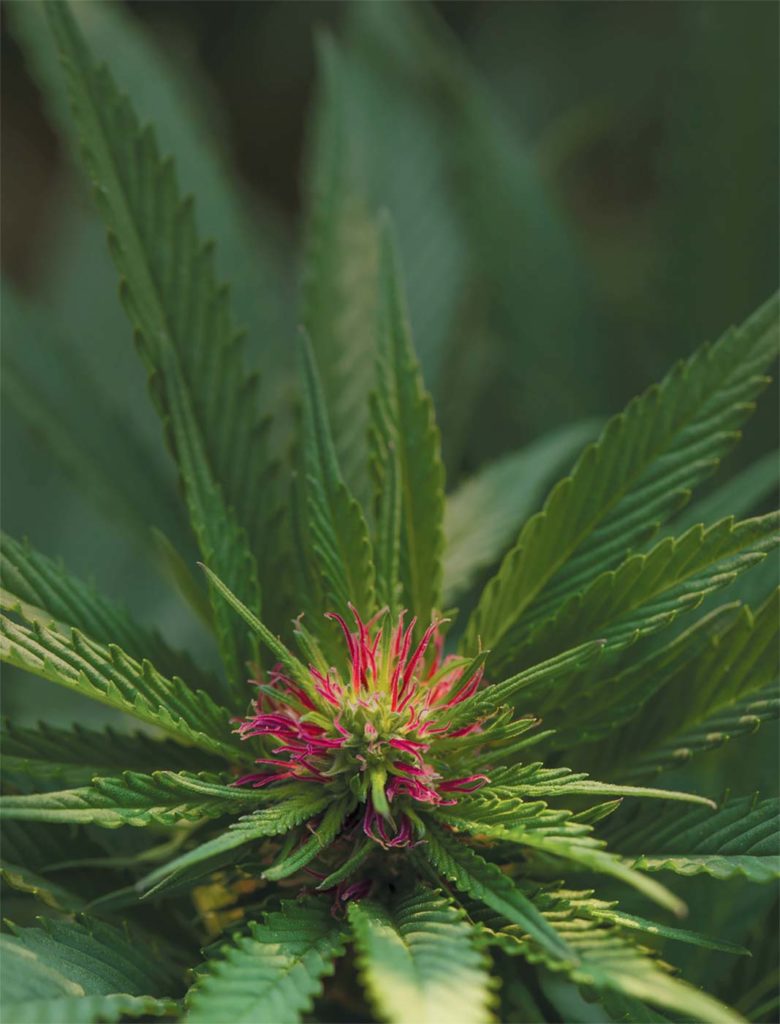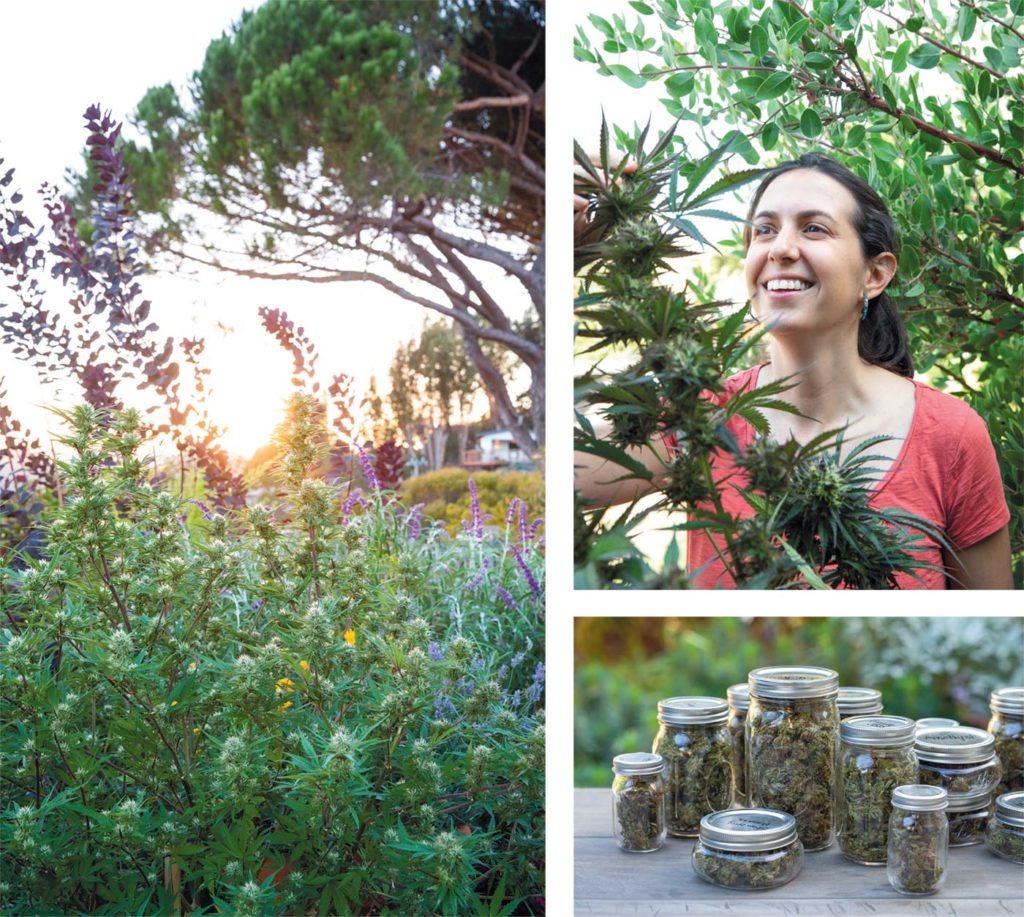PHOTOGRAPHY BY RACHEL WEILL

Forget the grow lights and fancy fertilizers, a gardening expert explains how to grow your own in 10 easy steps
Whether you’re already a fan or just cautiously curious, cannabis, fully legal for recreational cultivation and use in California, is a fantastic plant to include in the garden. Forget what you’ve ever heard about complicated growing practices—that comes from indoor cultivation, where weed has been forced to grow due to a century or so of prohibition. Outdoors, with sunshine and compost, the plant grows quickly and easily, smelling unlike anything you’ve ever included in the garden, making it a most perfect addition to this year’s bounty. There are myriad cultivars to choose from, including CBD-dominant ones that won’t get you high. No matter what, it’s a gorgeous plant in the garden.
1 PICK A SPOT
Weed is a quick-growing summer annual. If you’ve got an existing veggie bed, that’s your spot. If not, you want full sun. In gardener speak, that means at least six hours of direct sunlight a day. You also need well-amended soil, and access to water; drip is ideal. A container works fine too. The bigger, the better. Fifteen gallons is great, and drainage is a must.
2 PROCURE SEEDS OR A CLONE
Dispensaries are the only legal spot to score seeds and clones (what gardeners might otherwise call vegetative cuttings). While it might be tempting to grab a clone, consider starting from seed. Seeds are remarkably easy to grow. Start them in smaller cell packs filled with fresh potting soil and plant them ¼-inch deep and keep them watered. They’ll be just fine outdoors. Unlike clones, which are petite versions of older plants, seeds are spritely, young juveniles. They form strong taproots and are most resilient when it comes to any subpar spring conditions. Don’t sweat your selection—choose based on what name or smell you like. All that information about what it will do to you? Entirely subjective.
3 GET GROWING
Once the plant is about a foot tall, plant your weed into its eventual home, either bed or container, and watch it grow. Water anytime the soil is dry, down to about half an inch. Some simple trellising—like a tomato cage—will help the plant support its weight as it grows and eventually forms heavy flowers. You’ll want to prune it gently, at least topping it (snipping at the terminal bud) when there are three to five sets of leaves.
4 SEX THE PLANTS
If you’re growing from seed, you’ll need to “sex the plants.” Cannabis has both males and females, and you’re after unpollinated (aka seed-free) flowers as the end goal. While flowering won’t kick off in earnest until after the summer solstice, you can most likely sex them earlier (at, say, two months of age), by getting up close and personal with their pre-flower. You’ll want to look at plant nodes (the spot between the stem and the branch, akin to the armpit). That flap that looks like a flag is called the stipule. Peel that back and you’ll find the sex organ. If you see balls, it’s a male, and if you see a white hair, you’ve got a female. If you’re not sure, give it another few weeks. Male plants should be culled.

5 COMBAT PESTS
Nearly all problems with growing cannabis can be nipped in the bud with proper conditions (plenty of sun, room between plants for airflow, not too much water) at the outset. One persistent problem, however, is bud rot—caused by butterflies laying their eggs in the flowers, hatching into caterpillars that poop inside, eventually forming fungus that you really don’t want to ingest. You can either make peace with losing some of your harvest to this rot (which looks like gray, soft flowers at harvest time), or by giving plants a weekly spraying of Bt (Bacillus thuringiensis), an organic biopesticide that’s toxic to caterpillars and not at all toxic to you. Spray weekly from July through August.
6 HARVEST TIME
Depending on the cultivar, your flowers are ready to snip sometime in September or October. Flowers are ripe when half the stigmas (those hair-like strands sticking out from the buds) are amber and half are still white. If possible, chop your plants in a way that creates ready-made hooks for easy drying. Instead of cutting branches off from the main trunk or stem, try to include a small section of that trunk to create a V. And don’t worry if your hooks aren’t perfect or don’t happen every time— clothes pins are cheap and do the job, too. Place your harvest on a clean tarp that you can easily transfer to your drying spot.
7 DRY
Cannabis needs to hang out in a cool, dark spot to dry. A garage or closet will do. Maximize drying space by hanging a line, adding hangers, and suspending branches on hangers, either using their natural nooks or with the assistance of clothes pins. Invest in a cheap hygrometer to ensure that temperatures remain between 60° and 70° F and humidity stays between 50% and 65%. Add a small, oscillating fan to maintain airflow. In 10–14 days, when the branches snap and buds sound like popcorn when pressed, you’re ready to snip the buds off of branches and put them into airtight containers, like Mason jars with locking clasps.
8 CURE
This final step pulls any remaining moisture out from deep within the bud and creates an even dry. When your bounty first goes into their jars, seal them overnight and check on them the next day. If the flowers seem to have regained their moisture (as measured with a gentle squeeze), leave the lid off all day before resealing at night. Repeat this process, known as burping, until they’re as dry as they were the night before.
9 STORE
Store your cannabis in airtight containers in a cool, dark place—quite similar to drying conditions. Make sure vessels aren’t overpacked and consider adding a two-way humidity pack (Boveda is the brand loved by most) to keep conditions perfect.
10 ENJOY
Smoked, soaked in alcohol for a tincture, simmered in coconut oil for cooking or given away—your weed is bound to make someone happy.
About the author
Johanna Silver’s book, Growing Weed in the Garden: A No- Fuss, Seed-to-Stash Guide to Outdoor Cannabis Cultivation (Abrams), was published right when the world shut down. Previously she was the garden editor of Sunset Magazine, where she earned a James Beard Award for her writing. Johanna lives and gardens in Berkeley.
- This author does not have any more posts.


